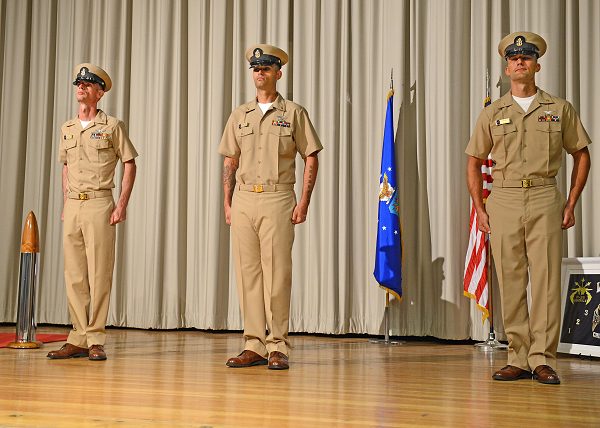To best understand the Navy promotion timeline, there are several factors to consider regarding how the Navy advances enlisted members.
First, the Navy uses a sailor’s rate to determine rank.
Enlisted rates have three different groups, including:
- General – E-1 to E-3
- Petty Officers – E-4 to E-6
- Chief Petty Officer – E-7 to E-9
Also, a sailor’s rating is a combination of their experience, skill level, knowledge, aptitude, and training.
Related Article – Navy SEAL Training: Basic Underwater Demolition
Navy Promotion Timeline and the Final Multiple Score System

Final Multiple Score (FMS) is the calculations used by the Navy to decide if an enlisted member can promote to the next level.
Six categories create this overall score.
Performance Mark Average/ Reporting Senior’s Cumulative Average (PMA /RSCA PMA)
This category includes the calculation of the sailor’s Individual trait Average (ITA) with the RSCA.
Exam Standard Score
This exam gives the board unbiased information on the qualifications of the sailor as they consider advancement.
Award Points
You will earn points for receiving awards.
Also, the awards must be earned before the day of the exam mentioned above.
Pass/Not Advance
If you pass the exam but are not advanced for a promotion, you earn points because you showed you have superior performance.
You retain points for the next advancement cycle.
Service in Paygrade
This section gives points to acknowledge the experience you gain in the job you do in the Navy.
Education
Your education points accumulate as you seek opportunities to increase your level of education independently.
Therefore, you earn points for accredited college degrees.
Navy Promotion Timeline for Seaman Recruit, Apprentice, and Seaman
This first group in the Navy features automatic promotions.
Time-in-Rate (TIR) is the amount of time spent in a rate to advance to the next level.
Also, to advance between E-1 to E-2 requires a TIR of nine months.
Finally, to continue from an E-2 to an E-3 requires nine more months.
E-4 through E-7 Promotion Requirements
There are basic general requirements to consider for promotion starting with E-4 to E-7.
These include:
- Advancement Exam
- Performance Evaluation
- TIR
Once all this information is gathered, as well as requirements specific to each rating, it is sent to the promotion board.
Also, the promotion board tallies all his information and uses a point system to add up your achievements.
The highest-rated sailors are eligible for promotion depending on availability, which depends on current manning levels.
Related Article – Navy Officer Candidate School
Petty Officer Third Class (E-4)
As your level of skill and responsibility increases, so will your opportunities for advancement.
However, promotion from Seaman to Petty Officer Third Class is competitive.
This rating is considered a Noncommissioned Officer in the Navy.
Also, you must have six months of TIR as an E-3, and you graduated your A-school and earned your rating for your occupation.
Furthermore, the Navy replaced a Leadership course with an Enlisted Leader Development (ELD) as a requirement for advancement.
Petty Officer Second Class (E-5)
Petty Officer Second Class is a Noncommissioned officer position and is highly competitive, as well.
Also, to promote to a Petty Officer Second Class, you need 12 months of TIR.
Furthermore, you need the Enlisted Leader Development (ELD) course.
Petty Officer First Class (E-6)
For promotion to Petty Officer First Class, you need 36 months of TIR as a Petty Officer Second Class.
Also, the Enlisted Leader Development course is necessary.
Chief Petty Officer (E-7)

Chief Petty Officer promotions require 36 months of TIR before consideration.
Also, one of the other first steps for this promotion is the Chief Petty Officer Leader Development Course (CPOLDC).
The CPOLDC is a part of the ELD but designed for the needs of Chief Petty Officers.
Related Article – DEVGRU: 7 things you didn’t know about SEAL Team 6
Senior Petty Officer (E-8)
This rank includes supervisory responsibilities, including training enlisted personnel.
Lastly, this position requires 36 months of TIR as an E-7 before consideration.
Master Petty Officer (E-9)
Before consideration for promotion to Master Petty Officer, you must have 36 months TIR as an E-8.
This position is a senior enlisted petty officer in the Navy.
Therefore, there is an exceptional amount of respect extended to those who achieve this rating.
Master Petty Officers help form the policy they implement.
Related Article – Best Navy Officer Jobs
FAQ
The Navy promotion timeline has nuances, and you may have additional questions.
What is the Enlisted Leader Development (ELD) Course?
This course, which replaced the previous leadership course, is necessary for promotion between E-3 and E-6 Sailors.
The course handles ethics, character, decision-making skills, coping with stress, as well as self-awareness.
Also, these courses are not necessarily all at once because they are designed to continue over several years as ongoing formal training throughout a sailor’s career.
Are There Opportunities for Advanced Pay Grade at Time of Enlistment?
Having college credit is a vocational or technical school may mean you could enlist at an E-2.
Furthermore, 24 semester hours may also make you eligible to enter as an E-2.
Also, those who complete an associate degree have opportunities to enter as an E-3.
Those who earn 48 semester hours are eligible to enter as an E-3, as well.
There are other opportunities for advance rank by participating in the following:
- Civil Air Patrol
- Eagle Scouts and Girl Scouts
- Special Referrals
- JROTC
- Navy Sea Cadets
- High School Military Academy
Your recruiter will advise you on a course of action to ensure you enlist with the highest rank possible.
Are There Advancement Opportunities in Some Jobs?
There are positions in the Navy that create opportunities for sailors to advance quickly.
The factor that impacts this opportunity is the number of vacancies present in one particle rating.
Therefore, it is difficult to predict when this will happen and in what rating.
However, The Navy publishes lists of the analysis of the fleet to predict opportunities.
What Is the Promotion Board?
The promotion board looks at all the details of a person up for promotion.
Also, the board considers the achievements of the sailor using a point system.
Furthermore, the board considers current manning levels to decide promotions.
Conclusion
Your navy promotion timeline depends on many factors.
Early ranks promote quickly and based on TIR.
However, as ranks become more competitive, a system is in place to calculate points.
The points take into consideration a sailor’s accomplishments and efforts before promotion.
References:
- Navy Promotion Timeline for Enlisted & Officers - June 19, 2024
- Navy SEAL Training (BUD/S) - June 19, 2024
- Navy Aircraft Carrier Flight Deck Shirt Colors Explained - June 19, 2024





